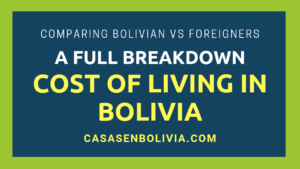Last Updated on February 14, 2025
Bolivia is home to approximately 150,000 foreign residents. Most originate from South American countries, but a few thousand come from developed nations. The vast majority of expats choose to live in Santa Cruz, with La Paz being the second most popular choice. Cochabamba, Sucre, and Tarija are also selected for their pleasant climates and scenic landscapes.
Expats from the US, Canada, Europe, and other developed countries almost exclusively (>95%) reside in Bolivia’s most exclusive neighborhoods and zones. There, they can enjoy a comfortable lifestyle with approximately $1,200/month per person, accessing the services, safety, and goods they would expect in their home countries.
In this article, we’ll describe where expats typically reside in our country. We are real estate and business experts from Bolivia, who have lived here our entire lives. Therefore, we know and have observed where expats generally settle once they move to Bolivia. With that said, let’s get into the details.
The Current Situation for Expat Residence in Bolivia
Currently, around 150,000 foreigners and expats live permanently in Bolivia. Of this number, only about 12,000 (8%) are from the US and other developed countries. The remaining expats come from Brazil, Argentina, other South American countries, and Spain. Most Asian residents, primarily from China, have settled in Santa Cruz, and there are very few Indian residents in the country.
The majority of expats permanently residing in Bolivia are from South America and Spain. They have settled *across all zones and neighborhoods* here. You can find foreigners from these neighboring countries living even in low-income neighborhoods, and many are students from Brazil and Argentina.
You’ll find many Peruvians in the western region of Bolivia, in La Paz and Oruro cities, and numerous Brazilians, Argentinians, and Chinese in the eastern region, in cities like Santa Cruz and Cobija. In contrast, foreigners from the US, Europe, and similar developed regions *reside almost exclusively in very specific, small, and affluent neighborhoods*.
Specific Locations Where Expats from Developed Countries Live
As we mentioned, many expats from overseas live permanently in Bolivia, *but only around 12,000 are from the United States and other developed countries*. In this article, we’ll focus on where expats from developed nations typically settle and live.
Expats and individuals from developed countries who relocate to Bolivia typically choose to live *almost exclusively in the best and most expensive neighborhoods and areas of the major cities*.
In these locations, you can live comfortably with around $1,200/month per person (approximately $3,500 for a family of two parents and three children). This amount of money is substantial for most Bolivians, but relatively modest for expats from developed countries. With this monthly income in Bolivia, *you can enjoy a lifestyle comparable to that of a wealthy Bolivian citizen* and access the comforts and quality of life a middle-class person in the United States typically enjoys.
The 5 Most Common Places Where You Can Find Expats from Developed Countries
Here, we’ll highlight the most likely places to find expats from developed countries living in Bolivia. While expats from South American countries can be found in almost any neighborhood or zone, those from developed countries are almost non-existent anywhere *except for Bolivia’s most exclusive and expensive neighborhoods*:
- Equipetrol and Urubo in Santa Cruz.
- Calacoto and San Miguel in La Paz.
- Cala Cala in Cochabamba.
- Barrio Petrolero in Sucre.
- Miraflores in Tarija.
| Place Where Expats Live | Approx. No. of Expats from Developed Countries | City | Neighborhood Type | Monthly Income Needed to Live Comfortably |
| Equipetrol | ~5,000 | Santa Cruz* | Downtown, both residential and commercial | $1,200/person; $3,500/5-member family |
| Urubo | ~1,000 | Santa Cruz* | Suburban, primarily residential | $1,500/person; $4,000/5-member family |
| Calacoto | ~3,000 | La Paz | Downtown, both residential and commercial | $1,200/person; $3,500/5-member family |
| San Miguel | ~1,000 | La Paz | Downtown, primarily commercial | $1,500/person; $4,000/5-member family |
| Cala Cala | ~1,000 | Cochabamba* | Downtown, both commercial and residential | $1,000/person; $3,000/5-member family |
| Barrio Petrolero | ~100 | Sucre* | Suburban, primarily residential. | $800/person; $2,500/5-member family |
| Miraflores | ~100 | Tarija* | Suburban, primarily residential | $800/person; $2,500/5-member family |
*The Chagas parasite is endemic in these areas.
In these zones, expats from developed countries can enjoy a quality of life comparable to that of a typical suburb in their home countries.
1) Equipetrol and Urubo in Santa Cruz City
By far, these two neighborhoods are the most expensive and exclusive in this city, and you’ll find many residents from developed countries living there. These neighborhoods feature large supermarkets, top-tier hospitals, food franchises, the best gym brands, large commercial centers and malls, the best high schools and colleges, and so on (in Bolivia, neighborhoods are not solely residential but also commercial and multi-purpose).
These areas are *almost exclusively inhabited by affluent Bolivians* who seek a quality of life similar to that of residents in developed countries. Furthermore, Santa Cruz de la Sierra has the highest number of expats from developed countries, most of whom come with the intention of establishing businesses and engaging in commercial activities in the city.
These two neighborhoods are known for being very calm and quiet, with Equipetrol being both residential and commercial and Urubo primarily residential. Few people walk on the streets, and most residents have their own cars for transportation. All green spaces are well-maintained, and security is high both on the streets and within homes. A typical house there is priced between $300,000 and $3 million.
2) San Miguel and Calacoto in La Paz City
The situation is similar in La Paz. You can explore the entire city and you’re unlikely to find any expats from developed countries living outside of these two neighborhoods. These zones offer, again, everything you’d find in an average suburb of a developed country, with the added benefit of numerous commercial centers, top-tier hospitals, and the best schools, all within walking distance. Security against theft is also high.
As you might expect, only a few thousand expats live in this area; it’s not as large a population as in Santa Cruz. However, both zones are populated by high-income residents of La Paz, and the atmosphere is similar to that of a downtown area in a developed country.
In both zones, people tend to walk, and if they need to travel to other parts of the city, they use their own cars. The streets are very clean and well-maintained, and security is very high. You’ll find numerous condo high-rises with hundreds of apartments for sale, as well as exclusive houses typically priced between $400,000 and $3 million.
3) Cala Cala in Cochabamba City
The same situation applies in Cochabamba; you won’t find individuals from developed countries anywhere *except in this neighborhood*. This zone offers the best quality of life throughout the city. For example, you can find everything you’d expect in a suburban area of the United States.
Only a few hundred expats from developed countries currently reside in Cala Cala, and almost none live outside this neighborhood. Many high-income residents of Cochabamba also live there. It’s worth noting that Cochabamba currently doesn’t have a large expat population from developed countries, but this number is gradually increasing.
This neighborhood also features numerous buildings and high-rises and is modern and quiet. You’ll find many green areas and parks. Numerous commercial establishments are present, and people tend to frequent brand-name restaurants, which are widespread throughout the area. Everything is clean, and the streets are not deserted, with people always around. A typical house here can range in price from $300,000 to $2,000,000.
4) Barrio Petrolero in Sucre City
Very few expats from developed countries live in this city; only a handful will be found in one of Sucre’s best neighborhoods, Barrio Petrolero. In this zone, you can find some of the amenities you’d expect in a small town in a developed country. However, this city lacks very large or expensive facilities for accommodation, education, healthcare, and similar services.
You’ll find it very challenging to connect with other expats from developed countries in this neighborhood. Instead, you’ll be surrounded by many high-income Bolivians. People from other countries typically come to this city seeking peace, tranquility, pleasant weather, and beautiful scenery.
5) Miraflores in Tarija City
This is one of the most exclusive neighborhoods in this city. Very few expats from developed countries can be found here, and they are non-existent in other parts of the city. However, in recent years, the population of foreigners from overseas has been growing, primarily due to the weather, landscapes, and the peaceful and beautiful surroundings.
You’ll find that living in this neighborhood is comparable to living in a small town in a developed country, with some buildings and at least decent services, such as restaurants, hospitals, and education. However, don’t expect to find anything truly large, modern, or complex. Foreigners find this city a quiet and peaceful place to live.
Caution: Health Risk!
You must exercise extreme caution *in these last four cities* due to the risk of “Chagas disease,” a serious illness that damages the heart, can be fatal, and has no cure. It’s endemic in these cities (in Cochabamba, 35% of the population carries this parasite, up to 54% in Sucre, and 48% in Tarija).
If you believe Santa Cruz is safer in this regard, that’s not the case. In Santa Cruz, 22% of the population has Chagas.
You should always seek living spaces *that are fully plastered, without any cracks, and take other precautions*. Be extremely vigilant!
Places Expats from Different Countries Choose
US and Canadian Expats
Nearly all expats (>95%) and foreigners from both countries reside solely in Bolivia’s best areas and neighborhoods. You’ll find almost no one from the US or Canada living in typical or low-income neighborhoods of Bolivian cities. *They can be found only in the most exclusive areas and zones of major Bolivian cities*.Places like Equipetrol in Santa Cruz, Calacoto in La Paz, or Cala Cala in Cochabamba are where expats from both countries feel comfortable because everything functions very similarly to downtown areas and suburbs in the US and Canada. There, you’ll find a high quality of life and comfort, good entertainment options, top-tier hospitals, excellent educational institutions, large supermarkets, well-maintained streets, etc.
If you have an income exceeding $1,200/month for yourself alone, or over $3,500/month for you and your family, you’ll be able to live in Bolivia’s most exclusive neighborhoods, experiencing a respectable quality of life, numerous amenities, and almost every service you’d expect in an average neighborhood in the US and Canada.
European Expats
Similarly, it’s very uncommon to find expats from Europe living outside of Bolivia’s most exclusive neighborhoods. Furthermore, it’s difficult to find expats from European countries residing in the country; there are far more from the US. *You might find several hundred per major Bolivian city*, and most are concentrated in the Equipetrol, Calacoto, and Cala Cala neighborhoods.
Small communities from these countries exist in Bolivia, and most are concentrated in high-income neighborhoods. *The quality of life they experience in these locations is the same as that of expats from the US and Canada*.
Bolivian neighborhoods have an interesting characteristic: they are multi-purpose, serving as both residential and commercial areas. Also, they are typically quite crowded with pedestrians throughout most of the day. However, you won’t find extensive support for cyclists traveling through these neighborhoods. As a European, you might feel as though you’re in the downtown area of a small city in England, the Netherlands, or France.
Asian Expats
The largest Asian community in Bolivia resides in Santa Cruz de la Sierra City. Significant Asian communities are present, most of them (>80%) from China, with notable communities from Korea and Japan as well. In other parts of Bolivia, it’s very difficult to find expats from these countries; *outside of Santa Cruz city, they are uncommon*.
You might find a few thousand Asian expats living in Santa Cruz city (approximately 10,000 people), *but they don’t reside exclusively in the best neighborhoods of this city. Instead, they are dispersed throughout the city*, and their incomes vary considerably. Both lower-income and affluent Asians are present, many of whom come to work in Bolivia seeking opportunities and employment.
Indian Expats
Expats from this country have almost no presence in Bolivia; *it’s very rare to encounter an individual from India living here*. Perhaps a few hundred reside across the country. They are also not concentrated in any particular area; they are dispersed throughout Bolivia.
Places Expats Avoid When Moving to Bolivia
Individuals from developed countries generally avoid living in neighborhoods and zones with a quality of life below what they are accustomed to. A person from the United States would find it very challenging to communicate and live comfortably in a typical Bolivian neighborhood, as almost no one speaks English. Furthermore, in standard areas, services and goods are of lower quality for someone from a developed country.
Expats from developed countries are aware of the risks associated with living in a typical or low-income neighborhood in Bolivia, where they can easily become targets for robbers and scammers. They also understand that they won’t experience a comfortable lifestyle and will face numerous challenges with even basic services, such as water, internet, gas, lower-quality hospitals, lower-quality education, and limited security. Additionally, as they would be the only expats living in these areas, they would be perceived as very unusual by everyone else.
Because expats from developed countries desire a quality of life at least comparable to that in their home countries, they will almost exclusively reside in Bolivia’s most exclusive neighborhoods, *where they can find amenities and services similar to those available in a typical urban area of the US*.
Almost the same holds true for expats from Europe. Most are high-income individuals who will only live in the most exclusive areas and zones of the major cities, with access to high-quality services surrounding their homes and living alongside other high-income expats.
For expats from Asia, *the situation is different*. Many come to work in Bolivia in search of opportunities. Therefore, most are lower-income individuals and are dispersed throughout Santa Cruz city, including exclusive neighborhoods as well as average and lower-income areas.
Conclusions:
In this article about where expats currently reside in Bolivia, you’ve seen that there are three primary categories of expats, based on their place of origin.
The first group consists of expats from developed countries, who reside almost exclusively in Bolivia’s most exclusive neighborhoods. The second group comprises expats from Asia, who are primarily present in Santa Cruz de la Sierra and throughout the city. The third group includes expats from the rest of the world, mostly from South America, who are present throughout Bolivia and represent the largest number.
You’ve also learned that there are very few Indian expats in Bolivia. Additionally, you’ve realized that it’s possible to find several thousand foreigners from developed countries living primarily in the Equipetrol and Urubo neighborhoods of Santa Cruz city, and to a lesser extent, in the Calacoto and San Miguel neighborhoods of La Paz city and Cala Cala in Cochabamba city. *Exercise extreme caution regarding Chagas disease in Cochabamba, Sucre, Tarija, and Santa Cruz*.
Finally, you’ve learned that foreigners from developed countries typically avoid living in standard and lower-income neighborhoods in Bolivia at all costs, as they know they’ll lack even basic services in some cases, won’t encounter peers from their home countries, and won’t be able to communicate effectively with local residents, not to mention the risks of being the only expat living in these areas.
We hope this information has been helpful. If you’d like to know more about what it’s like to live in Bolivia, including the pros and cons compared to other countries, please visit our dedicated guide here: Link.
CasasenBolivia.com, information on living, working, investing, and traveling in Bolivia.








